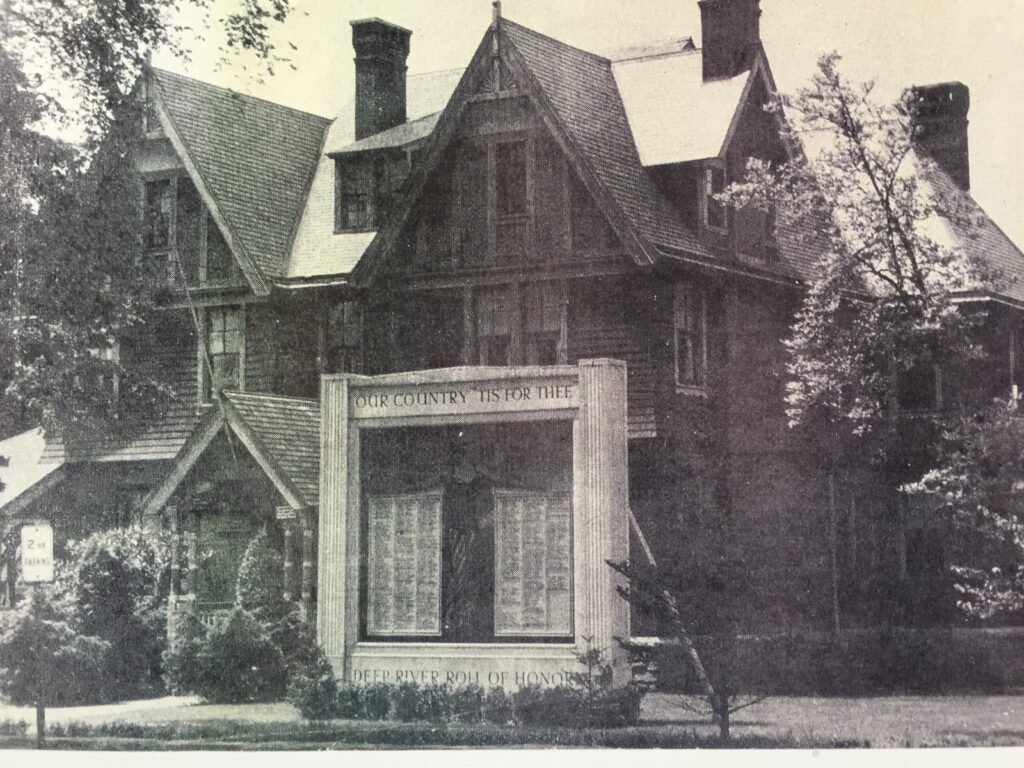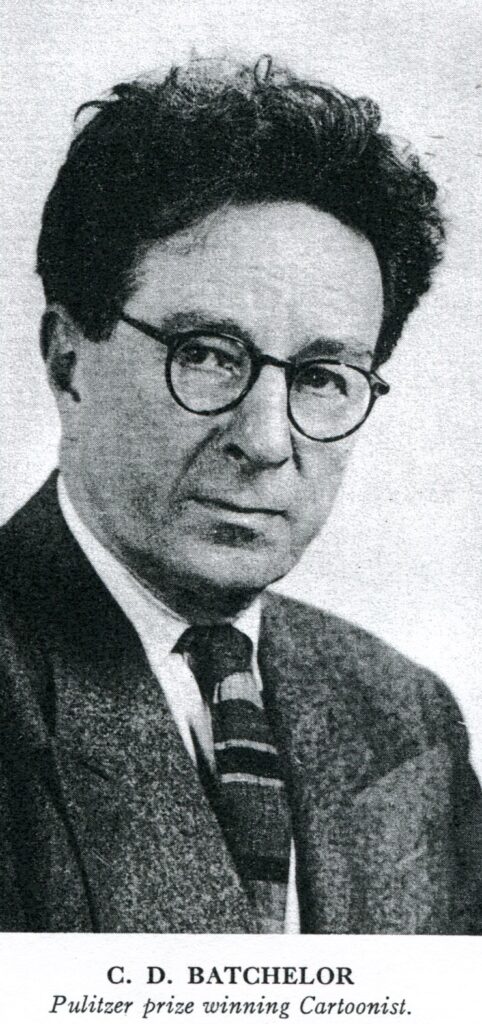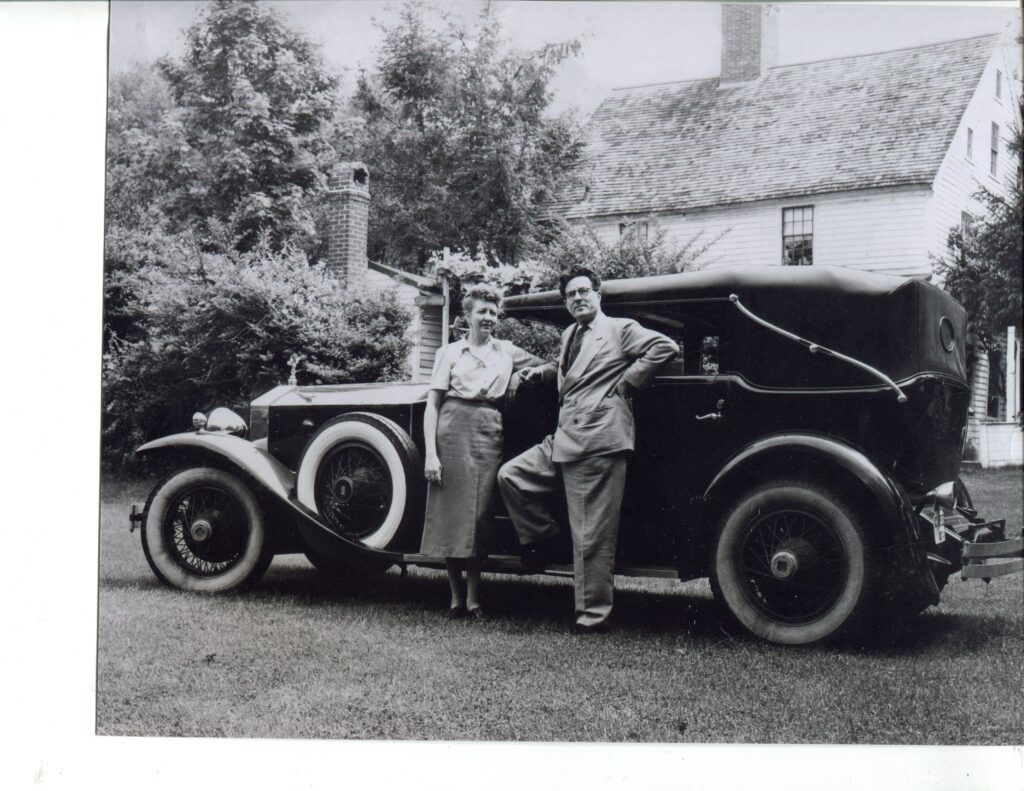Columbia was created by C.D. Batchelor in 1943. She was unveiled at the Deep River Library by Delores Smith, age 10, sister of Corporal Joseph Smith, the first Deep River “boy” to be killed in World War II and Mr. Batchelor on November 19, 1943. In 1970, Columbia was moved to Library Park, now renamed Veteran’s Memorial Green, on Main Street.
The painting, a larger-than-life figure of Columbia, was a gift to the town by Clarence Daniel Batchelor, noted Pulitzer Prize winner and cartoonist for the New York Daily News. Funds for the glass and wooden structure that would house the painting were raised by the people of Deep River. At the time of the dedication, the memorial displayed 270 names of Deep River residents who were serving in their country’s armed forces. At the end of the war, the list of names had grown to 330.
More than 1000 people attended the dedication in front of the Deep River Library on Main Street. Governor Raymond E. Baldwin gave an inspiring speech. There were musical sections by Mrs. John Gregory and prayers of invocation by Rev. Walter Euston. Master of Ceremonies was Arthur Croft, Commander of the Richard W. Ibell Post #61.

So why did Columbia move down Main Street to the green? The original structure built to house Columbia was constructed of wood and glass. By 1969 weather and the elements had caused significant decay. A committee was formed to relocate and reset Columbia on a more visible site. Her new framework was made out of glass and brick. This green triangle of land had been donated to the town for the purpose of a library and was named the Library Lot then later Library Park. Except Mr. Spencer’s home and land became available for the library project. So, the town never built a library on this site.
In 1985, a new Veteran’s Memorial Park committee organized to add “wings” to Columbia to honor those residents who served during the Korean and Vietnam conflicts.
In 1994 Columbia was suffering from leaks in her structure. The original Columbia was taken out of the memorial and she is now displayed in the town hall for her safety. A copy of Columbia was made and placed back into the refurbished brick structure. It was also voted to change the name of the park to Veteran’s Memorial Green.
In 2021, yet another committee redid the brick patio surrounding Columbia as a fitting tribute to our military veterans. Stop by and see the artwork of this incredible artist who so generously gave of his time to the town of Deep River.
More about the artist:

Clarence Daniel “C.D. or Batch” Batchelor was born April 1, 1888, in Osage County, Kansas. Batchelor attended Salina High School and upon graduation went to the Chicago Art Institute. Batchelor got his start as an editorial cartoonist with the Salina Journal, but soon after was hired as a staff artist for the Kansas City Star. In 1914 he became a free-lance artist and eventually moved to New York City where he worked for the New York Mail and the New York Times. In 1931 Batchelor became the chief editorial cartoonist for the New York Daily News. Batchelor’s cartoons often addressed issues concerning women’s suffrage, post-war repercussions, communism, as well as many other political and social issues.
Clarence Daniel “C.D. or Batch” Batchelor was born April 1, 1888, in Osage County, Kansas. Batchelor attended Salina High School and upon graduation went to the Chicago Art Institute. Batchelor got his start as an editorial cartoonist with the Salina Journal, but soon after was hired as a staff artist for the Kansas City Star. In 1914 he became a free-lance artist and eventually moved to New York City where he worked for the New York Mail and the New York Times. In 1931 Batchelor became the chief editorial cartoonist for the New York Daily News. Batchelor’s cartoons often addressed issues concerning women’s suffrage, post-war repercussions, communism, as well as many other political and social issues.
Clarence Daniel “C.D. or Batch” Batchelor was born April 1, 1888, in Osage County, Kansas. Batchelor attended Salina High School and upon graduation went to the Chicago Art Institute. Batchelor got his start as an editorial cartoonist with the Salina Journal, but soon after was hired as a staff artist for the Kansas City Star. In 1914 he became a free-lance artist and eventually moved to New York City where he worked for the New York Mail and the New York Times. In 1931 Batchelor became the chief editorial cartoonist for the New York Daily News. Batchelor’s cartoons often addressed issues concerning women’s suffrage, post-war repercussions, communism, as well as many other political and social issues.
Batchelor received the Pulitzer Prize for editorial cartoons in 1937 for a cartoon titled “Come on in, I’ll treat you right. I used to know your Daddy.” The cartoon depicts a skeleton representing War talking to a young man representing European youths.
Batchelor purchased a home on Kelsey Hill Road in Deep River and despite working in New York was an active member of this community. He was a founding member of the Deep River Historical Society and one of its early curators. He supported many causes and organizations in town, creating cartoons for scrap metal drives for the ambulance and fire departments, programs for the school musicals, and many other civic organizations. He retired from the Daily News in 1969. The Deep River Historical Society has a large collection of his art and his walking stick collection. The Elementary school children are most fascinated by the walking stick made out of shark’s vertebrae. Stop in and see it for yourself. He died September 5, 1977, in Deep River, Connecticut.

Post your pictures of Columbia on our Facebook Page or send in your entries to DRHS Curator Rhonda Forristall at rcforristall@gmail.com! Week 12 is the last week of our DRHS Summer Scavenger Hunt! Stay tuned for our culminating moment on Family Fun Day, September 18th at the Stone House!



